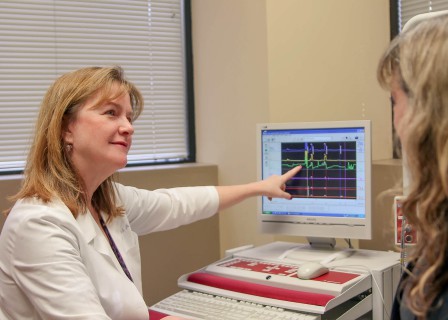
Indications for Urodynamic Testing:
If you have a problem with urination or urinary leakage, your physician may order a test called Multichannel Urodynamic Testing to evaluate the cause of your problem. This study assesses how well your bladder and urethra muscles work at storing and releasing urine.
Indications are:
* incontinence
* frequent urination
* sudden, strong urges to urinate
* problems starting a urine stream
* painful urination
* problems emptying your bladder completely
* recurrent urinary tract infections
Preparing for the Test:
This testing is performed at our Providence Road office only. Please call the day before to confirm insurance coverage and find out what your cost of payment will be. No special preparations are needed. Ask your MD if you should change diet or skip your regular medicines and for how long. Testing may be cancelled if urine infection signs are found on urinalysis. Allow 2 hours for appointment.
What are we testing?
The urodynamic evaluation is most often done in the medical clinic by a specialized
technician. It is comprised of four main sections:
Uroflowmetry – The patient is asked to urinate normally, while the strength of the urine
flow is measured. The patient is instructed to void to completion (i.e., empty their
bladder), and then the amount of urine left in the bladder after a normal void is
measured (post-void residual urine).
Electromyography – This portion of the test monitors the activity of the pelvic floor
muscles during filling and urination (contraction, relaxation). Small electrodes in the
form of patches are placed on either side of the anal opening, and remain there during
the entire testing procedure.
Cystometry – As the bladder is slowly filled with sterile water through a small catheter,
this test measures bladder sensation, looks for abnormal bladder contractions,
documents urinary leakage, and determines the filling capacity of the bladder (i.e., how
much it can hold). It also examines how well the bladder transmits appropriate signals to
the brain, to coordinate activity between the bladder and urethra/pelvic floor muscles
during filling and emptying.
Pressure/flow study – As the patient urinates, the bladder pressure required to initiate
and maintain the flow of urine is measured. Tiny, pressure-sensitive catheters placed in
both the bladder and rectum are used to measure this pressure.
Once complete, the physician will review the test and discuss with you an appropriate
treatment plan.
Taking the Test:
The specific type of test you take depends on your problem. Our nurse will use a catheter to empty your bladder completely. Then a special, smaller catheter will be placed in the bladder. This catheter has a pressure-measuring device called a manometer. Another catheter may be placed in the rectum or vagina to record pressure there as well. Your bladder will be filled slowly with warm water. During this time you will be asked how your bladder feels and when you feel the need to urinate. The volume of water and the bladder pressure will be recorded. You may be asked to cough or strain during this procedure. Involuntary bladder contractions can be identified. While your bladder is being filled, it may suddenly contract and squeeze some water out without warning. The manometer will record the pressure at the point when the leakage occurred. You may also be asked to apply abdominal pressure to the bladder by coughing, shifting position, or trying to exhale while holding your nose and mouth. Afterwards you will be asked to empty your bladder. You may be given an electromyography. This test measures the muscle activity in and around the urethral sphincter by using special sensors. The sensors are placed on the skin near the urethra and rectum.
After the Test:
You may have mild discomfort for a few hours after these tests when you urinate. Drinking an 8-ounce glass of water each half-hour for 2 hours should help. Ask your doctor whether you can take a warm bath. If not, you may be able to hold a warm, damp wash cloth over the urethral opening to relieve the discomfort. Your doctor may prescribe an antibiotic to take for 1 or 2 days to prevent an infection. If you develop signs of infection–including pain, chills, or fever-call VBOG at once at 757-425-1600.
